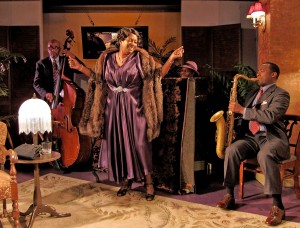The Devil’s Woman: “The Devil’s Music, The Life and Blues of Bessie Smith”
Some shows and their stars just don’t know when to quit. And it’s a good thing, because Miche Braden, the brilliant, ball-busting Bessie Smith of this blockbuster hit has been making magic with The Devil’s Music since June of 2011 at St. Luke’s Theatre—just a hair’s breadth away from the Great White Way. Who needs Broadway, when you’ve got Bessie?
When you hear such hits as “I Ain’t Got Nobody,” “St. Louis Blues,” “Gimme a Pigfoot,” and “Tain’t Nobody’s Bizness If I Do,” it’s impossible to separate the song from the songstress. Each number is joined at the head, the heart, and yes, even the swaying hips to its owner. And make no mistake, this “Empress of the Blues” in the skin of Ms. Braden, owns these tunes.
The song that opens and closes the show, “Get Out of My Way,” was actually written by Joe Brancato, the director, and Braden. “We just had to come up with an original song that would be just as alive today,” he confessed, “that would have our imprint as well.”
That it fits like a glove in this amazing repertoire is no surprise, considering the musical wizardry of these two. If Bessie were alive today, it would fit right into her own repertoire without missing a beat.
But the play is not just a glorified cabaret outing for these immortal melodies; it is a journey into the psyche of the singer herself. Bessie’s sassy recall — clouded by the post-Prohibition rotgut booze she’s come to prefer over the better brands she can now afford — ricochets back and forth between her rapt audience and the trio of backup musicians that share the stage with her. Playwright Angelo Parra has set the scene in a “buffet flat” in Memphis on an evening shortly before her death (accompanied by a bootlegger companion, Bessie Smith died tragically in a car accident in the early morning hours of September 26, 1937). Buffet flats were places where Blacks could gather after shows because, no matter how famous, they were prevented from staying in hotels. And Bessie, at her height, sold more recordings than anyone, other than Caruso or Al Jolson.
According to Parra, “‘Nobody Knows You When You’re Down and Out” could have been the soundtrack to her later life.” All the events in Bessie’s life he presented are based on fact. She was a hard-drinking, hard-loving woman of men as well as the ladies, who broke all the barriers and all the rules. There are more than enough sorrows to fill any script and Ms. Braden’s rendition of “I Ain’t Got Nobody” confronts the viewer and doesn’t let go.
The talented trio that accentuate Ms. Braden’s largely solo act is made up of bass player Jim Hankins, piano man Aaron Graves, and Keith Loftis on saxophone. They all provide credible backup support, but when Braden and Loftis perform “St. Louis Blues” together, it becomes a seismic heat wave of sexual energy.
How did they achieve such fireworks? In Brancato’s brilliant staging, the interlude is positively orgasmic. When experiencing the chemistry between this duo, one could only wish for more interplay with the remaining musicians. For this number, the director advised that he “wanted them to see it as an intercourse of music.” It’s down and dirty, perhaps, but his feeling was that performers like Bessie made love to their music in a way that may have seemed alien to a whiter, more conservative element.
The show has played a wide reach of venues before St. Luke’s, starting out at Penguin Rep in Stony Point, New York, a theatre that Brancato founded in 1977. The Devil’s Music ran for four weeks there and was brought back twice, enjoying overwhelming popularity. Would such popularity carry over in more conservative houses, such as at the Florida Repertory?
Brancato described audiences of matrons, not unlike the ones Bessie faced and referred to as “albino pigeons” in the script.
“Surprisingly, that audience gets it,” he emphasized, “because they know that music. They even dubbed Miche the ‘Viagra of South Florida.’”
He told his star that when facing a new, more challenging crowd, to “never pander to anyone. People can handle anything, if it’s honest and truthful. That’s the power of storytelling—where you came from, where you’re going.”
Miche Braden is no stranger to bio-plays like this one. Brancato met her in 1994, when she auditioned for his production of Lady Day at Emerson’s Bar & Grill. He knew he could stop looking then and there. A native of Detroit, she not only has the rhythms of Motown’s greatest hits in her veins, but studied under the great jazz artist Harold McKinney. For The Devil’s Music, she did all the arrangements and orchestrations in the play, as well as serving as Musical Director.
Commenting on what it is that keeps people coming back for more of these kinds of songs and the singers behind them, Brancato said, “The kind of compelling and passionate interpretation of their lives through song is what makes these women so extraordinary…we’re exposed to an experience that just moves the soul.”
The show will be featured this summer at the Montreal Jazz Festival and Canadians will finally have a chance to see what makes the rest of us keep coming back. One thing’s for sure, Satan’s music at St. Luke’s Theatre is downright heavenly.

For show and ticket information please visit http://stlukestheatre.com.

